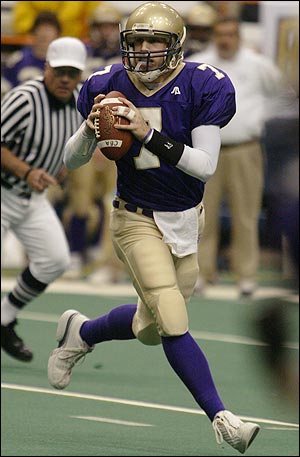Double-dipping not allowed
CHARLOTTE, N.C. (AP) -- All seemed lost for Tennessee after guard Tyler Smith fouled out with less than a minute remaining in Saturday's East Region final. The Volunteers needed a miracle to beat Notre Dame and advance to the Final Four for the first time in school history.
Instead, Tennessee got a Hail Mary.
Reserve guard Erik Ainge, who quarterbacked the Vols' football team to the SEC title game in December, made a 25-foot three-pointer as time expired to lift Tennessee to an 86-85 win. After Ainge's shot went through, Notre Dame point guard Greg Paulus crumpled to the floor.
"This feels even worse than losing to USC in football last year," said Paulus, who succeeded Brady Quinn in 2007 as Notre Dame's starting quarterback.
Sounds far-fetched, doesn't it? But a few generations ago, many of the best college athletes played every sport they could. Now, only a few -- North Carolina football/basketball standouts Julius Peppers and Ronald Curry come to mind -- get a chance to play more than one sport.
Just imagine if more college athletes diversified. Allen Iverson, who was Michael Vick before Michael Vick was Michael Vick, might have spurned Georgetown to play quarterback at in-state Virginia Tech. With Iverson at quarterback -- or safety; he once intercepted seven passes in a high-school game -- the Hokies could have dominated the Big East in football and been a solid citizen of the league in hoops.
You also might have witnessed that imaginary Tennessee-Notre Dame Elite Eight matchup in this year's NCAA Tournament. Ainge, the nephew of former Celtics great and standout amateur baseball player Danny Ainge, was a more-than-capable 6-foot-6 shooting guard in high school, and he probably could have played both sports. And after the Vols lost to LSU in the SEC title game, Phillip Fulmer -- knowing hoops coach Bruce Pearl had a special group that could compete for a national title -- might have let Ainge join the hoops team in December and let promising sophomore Jonathan Crompton start the Outback Bowl.
Meanwhile, Paulus might have been the nation's top quarterback in the recruiting class of 2005. He threw for 11,763 yards and 152 touchdowns during his career at Syracuse (N.Y.) Christian Brothers Academy, and he actually put off his decision to sign with Duke until April 2005 as he wrestled with the decision to play basketball, football or both. For our look into the two-sport-star parallel dimension, we assumed that if Paulus had chosen to play both sports, he would not have chosen Duke. Notre Dame was on his list of football finalists, and Paulus' signing would have been the first big coup of the Charlie Weis era.
In such a world, the college choice of quarterback prospect Terrelle Pryor would be even more complicated. The 6-foot-6 Pryor, an athletic wing forward on the court, received basketball scholarship offers from USC and others before deciding to focus on football. Pryor said Saturday he intends to sign with a school -- either Michigan, Ohio State, Oregon or Penn State -- later this week. He also said he has narrowed his options to two schools. The best guess is that he will pick between Michigan and Ohio State, but if hoops were factored into the equation, Pryor's list might look different.
In the class of 2009, 6-8 quarterback/power forward Brock Osweiler from Kalispell, Mont., might not have to make such a monumental decision in the next few months. Osweiler, who committed to play basketball at Gonzaga, must decide which sport he wants to play in college so he can choose between playing travel basketball and hitting the football camp circuit. If football coaches weren't so territorial -- an NCAA rule mandates a two-sport player must take a football scholarship or surrender two years of gridiron eligibility -- and if athletes weren't pushed so hard to pick one sport, someone like Osweiler could throw passes for Rick Neuheisel and grab rebounds for Ben Howland.
Besides, what could be more fun than watching a player score a touchdown in the Rose Bowl and then, three months later, slam dunk in the Sweet 16? If you can think of another football or basketball star you'd like to see playing both sports, fire off a note to my mailbag. I'll reveal the best suggestions sometime during the tourney.
Indiana's firing of Kelvin Sampson for repeated NCAA violations could decimate the recruiting class he assembled prior to his ouster. Point guard Terrell Holloway told Rivals.com last week that he expects to be released soon from the letter-of-intent he signed with Indiana in November. Meanwhile, fellow signee Devin Ebanks told the Indiana Daily Student he planned to meet with Indiana athletic director Rick Greenspan before he made a decision about his future. Ebanks, a 6-9 forward, is ranked as the nation's 13th-best player by Rivals.
Should Holloway and Ebanks decide to go elsewhere, they would be hot commodities in a market long on demand and short on supply. Most of the nation's best players signed in November, but many schools have identified needs since then. Should both receive releases, expect them to get a full-court press from dozens of programs.





